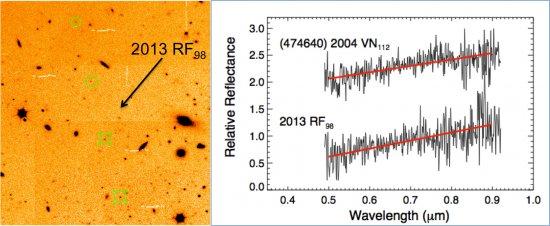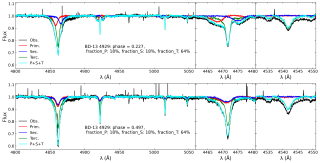The so-called extreme trans-Neptunian objects (ETNOs) are orbiting the Sun at heliocentric distances larger than 150 AUs, and their discovery a decade ago was soon recognized as a turning point in our knowledge of the outer Solar System. The currently tally stands at 21 ETNOs, and only one, Sedna, has been spectroscopically observed. In the last years several studies have suggested that the dynamical properties of the ETNOs could be better explained if one or several planets of several Earth masses are orbiting the Sun at hundreds of AUs. In 2016, Brown and Batygin used the orbits of seven ETNOs to predict the existence of a super-Earth in the sub-Neptunian mass range orbiting the Sun at 700 AUs: this is known as the “Planet Nine” hypothesis. Among these seven ETNOs, the pair 2004 VN112 – 2013 RF98 clearly stands out, the two objects having almost identical orbits with an angular separation between their directions of perihelia and orbital poles extremely small. This suggests a common dynamical origin: in September 2016 we used the OSIRIS camera-spectrograph at the 10.4m GTC telescope to obtain visible spectra of this pair of ETNOs to unravel their physical nature. The obtained spectral slopes for the two objects were almost identical, 12 ± 2 %/1000Å and 15 ± 2 %/1000Å for 2004 VN112 and 2013 RF98, respectively, and consistent with those obtained by other authors for 2000 CR105 (14%) and 2012 VN113 (13%) using photometric data. These values indicate the possible presence of amorphous silicates in the surface of these objects, as is the case of Trojans or Centaurs, but never dominated by complex organics. In contrast, Sedna presents a value of 42%, having a ultra-red surface material, typically organics, very different from the rest of ETNOs. These five objects belong to the group of seven used to present the Planet Nine hypothesis, suggesting that they all may share a common region of origin, with the exception of Sedna, which is thought to come from the inner Oort Cloud. Therefore, the very similar spectral slopes for the pair 2004 VN112 – 2013 RF98 indicated a common physical origin, suggesting the possibility that this pair could have been a binary asteroid that was perturbed in the past after an encounter with a more massive object. To test the viability of this hypothesis we performed thousands of numerical experiments, analyzing the evolution with time of the angular separation between the orbital poles of the two objects. Our results favors a scenario in which 2004 VN112 – 2013 RF98 were once a binary asteroid that became unbound after a relatively recent gravitational encounter (5 – 10 Myr) with a planet with mass in the range 10-20 Earth masses, moving in an eccentric (0.1-0.4) and inclined (20-50 degrees) orbit, with semi-major axis of 300-600 AU.
The image on the left shows a composition of four acquisition images obtained during four consecutive nights (September 4, 5, 6, and 7, 2016), using the OSIRIS instrument at the GTC and the Sloan r’ filter. In this image we can see one of the ETNOs studie
Advertised on
References



